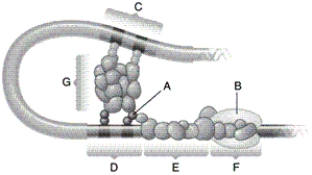Exam 14: Control of Gene Expression
Exam 1: Light and Life118 Questions
Exam 2: The Cell: an Overview158 Questions
Exam 3: Defining Life and Its Origins59 Questions
Exam 4: Energy and Enzymes80 Questions
Exam 5: Cell Membranes and Signalling85 Questions
Exam 6: Cellular Respiration64 Questions
Exam 7: Photosynthesis100 Questions
Exam 8: Cell Cycles93 Questions
Exam 9: Genetic Recombination99 Questions
Exam 10: Mendel, Genes, and Inheritance86 Questions
Exam 11: Genes, Chromosomes, and Human Genetics79 Questions
Exam 12: Dna Structure, Replication, and Organization74 Questions
Exam 13: Gene Structure and Expression106 Questions
Exam 14: Control of Gene Expression97 Questions
Exam 15: Dna Technologies91 Questions
Exam 16: Genomes and Proteomes48 Questions
Exam 17: Evolution: the Development of the Theory85 Questions
Exam 18: Microevolution: Changes Within Populations84 Questions
Exam 19: Species and Macroevolution90 Questions
Exam 20: Understanding the History of Life on Earth76 Questions
Exam 21: Humans and Evolution57 Questions
Exam 22: Bacteria and Archaea80 Questions
Exam 23: Viruses, Viroids, and Prions: Infectious Biological Particles41 Questions
Exam 24: Protists100 Questions
Exam 25: Fungi81 Questions
Exam 26: Plants80 Questions
Exam 27: Diversity of Animals 1: Sponges, Radiata, Platyhelminthes, and Protostomes88 Questions
Exam 28: Diversity of Animals 2: Deuterostomes: Vertebrates and Their Closest Relatives88 Questions
Exam 29: Population Ecology65 Questions
Exam 30: Population Interactions and Community Ecology71 Questions
Exam 31: Ecosystems67 Questions
Exam 32: Conservation of Biodiversity41 Questions
Exam 33: Putting Selection to Work94 Questions
Exam 34: Organization of the Plant Body70 Questions
Exam 35: Transport in Plants80 Questions
Exam 36: Reproduction and Development in Flowering Plants70 Questions
Exam 37: Plant Nutrition99 Questions
Exam 38: Plant Signals and Responses to the Environment95 Questions
Exam 39: Introduction to Animal Organization and Physiology65 Questions
Exam 40: Transport in Animals: the Circulatory System73 Questions
Exam 41: Reproduction in Animals102 Questions
Exam 42: Animal Development85 Questions
Exam 43: Control of Animal Processes: Neural Control103 Questions
Exam 44: Control of Animal Processes: Neural Control103 Questions
Exam 45: Control of Animal Processes: Neural Integration157 Questions
Exam 46: Muscles, Skeletons, and Body Movements71 Questions
Exam 47: Animal Behaviour126 Questions
Exam 48: Animal Nutrition108 Questions
Exam 49: Gas Exchange: the Respiratory System57 Questions
Exam 50: Regulating the Internal Environment73 Questions
Exam 51: Defences Against Disease117 Questions
Exam 52: Conservation and Evolutionary Physiology60 Questions
Select questions type
Suppose the lacI repressor gene is permanently silenced by a mutation. What would be the impact on the function of the lac operon?
Free
(Multiple Choice)
4.9/5  (34)
(34)
Correct Answer:
B
Match each term with its definition.
-benign
Free
(Multiple Choice)
4.8/5  (32)
(32)
Correct Answer:
J
How are the vast majority of proteins expressed early in an animal's development?
Free
(Multiple Choice)
4.8/5  (19)
(19)
Correct Answer:
A
Which of the following determines the rate at which proteins are made?
(Multiple Choice)
4.9/5  (36)
(36)
Identify each labelled part of this illustration of eukaryotic DNA.  -promoter
-promoter
(Short Answer)
4.9/5  (29)
(29)
Match each term with its definition.
-transcriptional regulation
(Multiple Choice)
4.7/5  (32)
(32)
Which type of RNA is transcribed in the nucleus, folded, cleaved by Dicer protein, and is then bound to a target molecule of mRNA?
(Multiple Choice)
4.8/5  (29)
(29)
Identify each labelled part of this illustration of eukaryotic DNA.  -proximal promoter region
-proximal promoter region
(Short Answer)
4.7/5  (33)
(33)
Which of the following proteins binds to the operator in the operon model?
(Multiple Choice)
4.8/5  (32)
(32)
Which of the following determines the availability of finished proteins?
(Multiple Choice)
4.9/5  (43)
(43)
Identify each labelled part on the illustration of the Lac operon.
 -promoter
-promoter
(Short Answer)
4.9/5  (30)
(30)
Where does RNA polymerase first bind to on the E. coli lac operon?
(Multiple Choice)
4.9/5  (38)
(38)
Suppose that a strain of E. coli containing a mutant lac operon is discovered. Also suppose that the mutant operon is normal in terms of its regulation, but the lacY gene produces a defective protein. Which metabolic function will be impaired in this bacterium?
(Multiple Choice)
4.8/5  (38)
(38)
Identify each labelled part on the illustration of the Lac operon.
 -RNA polymerase
-RNA polymerase
(Short Answer)
4.8/5  (33)
(33)
Identify each labelled part of this illustration of eukaryotic DNA.  -RNA polymerase
-RNA polymerase
(Short Answer)
4.8/5  (34)
(34)
Showing 1 - 20 of 97
Filters
- Essay(0)
- Multiple Choice(0)
- Short Answer(0)
- True False(0)
- Matching(0)